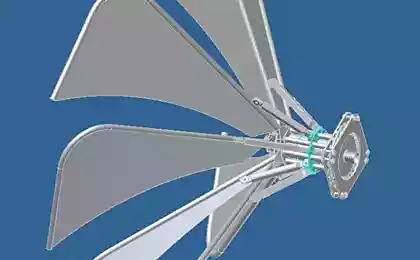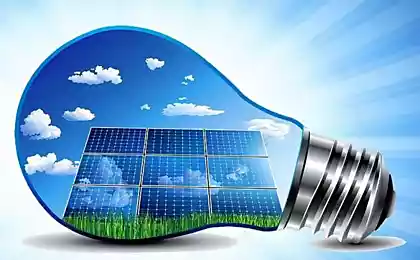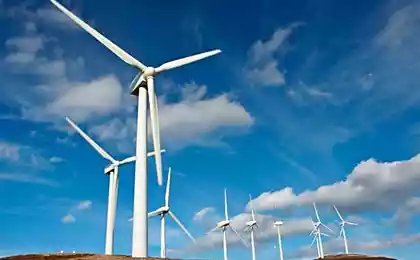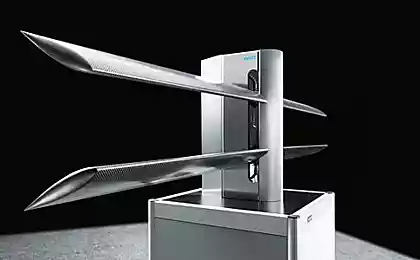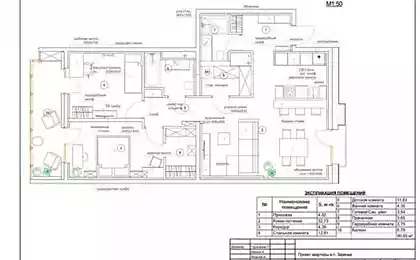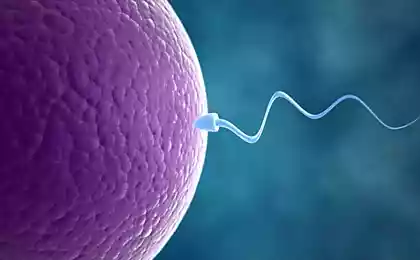707
Energy efficiency of wind turbines for the home
Forty eight million one hundred one thousand six hundred thirty four
Global energy demand is continuously growing, but soon this trend must face the exhaustion of world oil reserves that can produce energy crisis. In recent years, high hopes, in terms of solving global energy problems, rely on alternative energy sources and the latest technology. Wind power for some time became a symbol of alternative and green energy. This leaves open the question of energy and economic efficiency of wind turbines in different operating conditions in comparison with traditional sources of electricity.
In connection with the liberalization of the economy and individualization of society, the recent increased interest in Autonomous automated wind turbine that is not related to the grid and support individual housing.
The task is to study the energy and economic efficiency of automated Autonomous low-power wind turbines by statistical modeling methods.
The idea of using "free" wind energy to generate electricity in your own home at first glance very attractive. However, ironically, the electricity from a home wind turbine is paradoxically expensive.
On the one hand, the supply of the household must meet two mandatory conditions:
1 – it should be 220 VAC, 50 Hz;
2 – power supply should be uninterrupted. The wind is an unstable phenomenon, and a wind turbine will not directly be able to provide electricity to the house. Therefore, the cost of the wind generator need to add the cost of bulky and expensive electric batteries that accumulate the energy of wind. The battery produces DC current which must be converted to AC. This requires the inverter, the cost of which increases the cost of obtaining "free energy". The need to install a wind turbine on a high mast also increases costs.
On the other hand, all these additional devices cause energy losses during its storage and conversion.
Of interest is the question whether it is possible to achieve energy autonomy of private housing through the use of wind turbines, at least in the most favorable conditions for Ukraine of the Crimea, where the average wind speed reaches 7 m/s (in the desert on the coast and at higher elevations).
As a design option has been selected the modern wind power unit VEU-M-3/5. It meets power requirements and is a typical representative of its class. This is a classic three-bladed wind turbine with a fixed angle of the blades, the maximum electrical power of 3 kW, turbine diameter of 4.6 m and a rotation speed of 500 rpm Blade special design made of Stekloplastik special technology, has a long service life with low weight and ensures a low noise level. Mast kit (pipe extensions) is maximally simplified and cheapened.
Standard design the individual wind turbine
The Foundation of the wind turbine is specially designed for her low speed gearless generator. The principle of operation is three-phase multi-pole synchronous AC generator with excitation from permanent rare earth magnets.
The power of the wind stream is proportional to the cube of the wind speed and is calculated according to the formula:
The dependence of the power flow from the wind speed for a wind turbine wind turbines-M-3/5 given in the figure below. In the same figure is given the certified value of electric power of wind turbines is 3/5. In the working speed range of 3 – 11 m/s the coefficient of power of wind wind turbine wind turbines-3/5 is about 0.3. This is a good value for wind turbines. Even theoretically it is impossible to achieve the ratio of 0.6, but in reality, this ratio is still 1.5 – 2 times less. At high wind speeds the utilization factor decreases even more. So, at a wind speed of 20 m/s wind power reaches 80 kW but the generator is not able to use it. Unfortunately, it is technically impossible to provide a high utilization rate of wind power in such a wide dynamic range of its change (three orders of magnitude).
Power versus wind speed
Block diagram of the setup is shown in the figure below. The wind turbine generates three phase alternating voltage. Battery is charged via the rectifier constant current. This process is controlled by the charge controller. Battery is needed to smooth out random fluctuations of load and wind power. Regulation and limitation of the rotational speed of the wind turbine at high wind speeds (40 m/s) is achieved by electromagnetic braking of the generator. If the battery is already charged, the generated excess energy is dissipated in the resistive tubular electric heaters (teh-Ah).
The structural scheme of the power plant
Food appliances with AC 220V, 50 Hz is supplied from the battery through the inverter. In the absence of wind, use a backup gasoline generator. Although a backup generator can be directly fed into electrical appliances, this mode is energetically unfavorable. Most of the time a backup generator will be underutilized due to the variability of power consumption. Cheaper to charge from the battery (via a rectifier). While a standby generator will turn on occasionally and briefly, but at full capacity. In this mode, the resource hours diesel generator and fuel will be used most efficiently.
To quantify the variability of wind is characterized by the graphs of the density distribution and velocity autocorrelation function. Mean hourly average speed.
The frequency distribution describes the frequency of occurrence of different speeds. For wind characterized by a strong asymmetry of the velocity distribution. A suitable theoretical model is the Weibull distribution. The figure below shows the theoretical Weibull distribution. A parameter that defines the asymmetry, assumed equal to 1.5. The parameter b determines the average value, assumed to be 7 m/s Is typical for the Crimean winds values.
The frequency distribution of wind speed
The autocorrelation function reflects the relative stability wind speed at short time intervals (if at the moment of calm, then the probability that in an hour will also be calm). Typical characteristic time of the autocorrelation of the wind speed about 10 hours. For longer intervals interdependence dramatically weakened.
The autocorrelation function of the wind speed
The figure below shows a statistical model of the whole wind turbine (including battery backup and diesel generator) in the environment of the software VisSim. The beat of the simulation corresponds to 1 s to 1 hour in real time. The internal structure of a model hidden inside the unit Power Installation Model. Displayed waveforms of the main variables of the model.
Statistical modeling of the power plant
Generator capacity – potential capacity of generator (kW). The power the generator can output, if the consumer can to take. Otherwise, the actually generated power will be less.
Power generation is the generated real power (kW). It is used for charging the battery and the power consumer.
Power demand required by consumer power (kW). Due to the presence of the battery and a backup generator, the need is met 100%, that is, the required power is always the same as real power consumption. But power consumption does not coincide with the generated power, since the battery is charged due to the excess power generated, it is discharged to cover excess needs.
Charge – the battery charge (kWh). Changes in the range of 0 to 20 kWh (this is the maximum capacity of the battery).
Power reserve – power reserve gasoline generator (2.5 kW). Occasionally briefly turns on when wind is weak, when the battery is close to zero and it needs to be recharged.
Control characteristic, the backup generator is shown in figure below. A backup generator is enabled if the battery level falls below 2 kWh, and turns off when the battery reaches 7 kWh.
Control characteristic, the backup generator
Manufacturer of wind generator recommends the use of a battery with an energy capacity of 20 kWh (of daily energy). Is of interest to study the following question. Is it possible to do without a backup diesel generator, increasing the capacity of the battery? At first glance this seems possible, because the average potential capacity of the wind turbine exceeds the average demand. The figure below shows the dependence of the length of inclusions (PV) backup generator the capacity of the battery (according to the results of statistical modeling). The graph shows that PV really decreases uvelicheniem battery capacity. But even with a fourfold increase in capacity up to 80 kW-hours (then the battery would weigh 2 tons!) fails to bring PV to zero. Thus, to get rid of the backup diesel generator at the expense of increasing the battery capacity is almost impossible.
The dependence of the inclusions (PV) backup gasoline generator to the battery capacity
The figure below shows the balance of the average power of the wind turbine from the simulation results. The average power of the wind flow is sufficiently large and is 12 kW. However, the current wind power varies in a very wide dynamic range, from zero to hundreds of kilowatts. It is almost impossible to create a wind turbine that works effectively throughout the power range. Therefore the average utilization of power of the wind is low. So, the installed capacity of the generator is 4 times less that is only 3 kW. The maximum electric power can be obtained with stable wind speed of 11 m/s and a matched load. The excess of power at high wind speeds simply disappears. Given the instability of the wind, the average potential of the electric power will be 1 kW (and this is assuming that the load selects the entire generated power). If we take into account the inconsistency of the load (maximum consumption do not correspond to the maxima of the performance), the actual generated power will be even less than 1.6 times, amounting 0,636 kW (and this despite the presence of the battery). Utilization of installed generator capacity is only 0,636/3 = 0,021 = 21%. Into electrical energy becomes 0,636/12 = 0,053 = 5.3% of the initial energy of the wind.
The balance of average power
Backup diesel generator, occasionally activated when there is insufficient wind (DF=4,6%), adds the average 0,113 kWh. As a result, we get the average generated power of 0.75 kW.
The average generated power, kW
Due to losses in the battery and the inverter, the real power, given to the consumer will be even less (1.4 times) and will amount to 0,54 kW. This corresponds to the average monthly consumption 0,54·24·30 = 390 kWh of electricity. The composition of household electrical appliances and their use needs to be chosen accordingly. It is modest, but comfortable enough for a small individual house.
The total monthly electricity 1500 UAH sum of depreciation charges for the equipment installed 1080 UAH (the payback period adopted 10 years) and paying for gas for the backup generator 430 UAH.
The monthly fee for electricity, UAH
The cost per kilowatt-hour of electricity will 1500/389 = UAH 3.88, which is much more than the cost of electricity from the network.
Energy autonomy of private housing through the use of an automated wind turbine is technically achievable, however the fee for autonomy is high. The cost of wind power, even in the face of the Crimea (the best in Ukraine, the average wind speed to 7 m/s), is greater than when powered from the mains.
The energy efficiency of individual wind turbines is quite small. The average consumed electric energy is only 4.5% of the average power of the wind flow passing through the turbine, and 18% of the installed capacity of the generator.
The main constraint to increase the energy efficiency of the wind turbine, is a random variation of power of wind flow in a large dynamic range (three orders of magnitude).
It is recommended to use a wind turbine with a blade diameter of 4.5 m, a rotation speed of 500 rpm, the height of the mast 10 m, gearless multi-pole synchronous generator with permanent magnets with a power of 3 kW, battery energy capacity of 20 kWh, with a mass of 500 kg, a backup gasoline generator, 2.5 kW inverter 4.5 kW. This unit will provide the average electricity consumption of 390 kWh per month at a price of UAH 3.88 per kilowatt·hour.
For estimated payback period of 10 years will have three times to change the petrol and once the battery. The operation of the wind turbine is assumed trouble-free and maintenance-free.
Without a backup gasoline generator, it is impossible to ensure uninterrupted electricity supply even when a fourfold increase in battery capacity from the recommended. Therefore achievable only autonomy from the mains, but not from the supply of hydrocarbon fuel.
S. V. Nosov, L. G. Sobolevskaya, O. V. Chernyavskaya
Source: alternativenergy.ru
Global energy demand is continuously growing, but soon this trend must face the exhaustion of world oil reserves that can produce energy crisis. In recent years, high hopes, in terms of solving global energy problems, rely on alternative energy sources and the latest technology. Wind power for some time became a symbol of alternative and green energy. This leaves open the question of energy and economic efficiency of wind turbines in different operating conditions in comparison with traditional sources of electricity.
In connection with the liberalization of the economy and individualization of society, the recent increased interest in Autonomous automated wind turbine that is not related to the grid and support individual housing.
The task is to study the energy and economic efficiency of automated Autonomous low-power wind turbines by statistical modeling methods.
The idea of using "free" wind energy to generate electricity in your own home at first glance very attractive. However, ironically, the electricity from a home wind turbine is paradoxically expensive.
On the one hand, the supply of the household must meet two mandatory conditions:
1 – it should be 220 VAC, 50 Hz;
2 – power supply should be uninterrupted. The wind is an unstable phenomenon, and a wind turbine will not directly be able to provide electricity to the house. Therefore, the cost of the wind generator need to add the cost of bulky and expensive electric batteries that accumulate the energy of wind. The battery produces DC current which must be converted to AC. This requires the inverter, the cost of which increases the cost of obtaining "free energy". The need to install a wind turbine on a high mast also increases costs.
On the other hand, all these additional devices cause energy losses during its storage and conversion.
Of interest is the question whether it is possible to achieve energy autonomy of private housing through the use of wind turbines, at least in the most favorable conditions for Ukraine of the Crimea, where the average wind speed reaches 7 m/s (in the desert on the coast and at higher elevations).
As a design option has been selected the modern wind power unit VEU-M-3/5. It meets power requirements and is a typical representative of its class. This is a classic three-bladed wind turbine with a fixed angle of the blades, the maximum electrical power of 3 kW, turbine diameter of 4.6 m and a rotation speed of 500 rpm Blade special design made of Stekloplastik special technology, has a long service life with low weight and ensures a low noise level. Mast kit (pipe extensions) is maximally simplified and cheapened.
Standard design the individual wind turbine
The Foundation of the wind turbine is specially designed for her low speed gearless generator. The principle of operation is three-phase multi-pole synchronous AC generator with excitation from permanent rare earth magnets.
The power of the wind stream is proportional to the cube of the wind speed and is calculated according to the formula:
The dependence of the power flow from the wind speed for a wind turbine wind turbines-M-3/5 given in the figure below. In the same figure is given the certified value of electric power of wind turbines is 3/5. In the working speed range of 3 – 11 m/s the coefficient of power of wind wind turbine wind turbines-3/5 is about 0.3. This is a good value for wind turbines. Even theoretically it is impossible to achieve the ratio of 0.6, but in reality, this ratio is still 1.5 – 2 times less. At high wind speeds the utilization factor decreases even more. So, at a wind speed of 20 m/s wind power reaches 80 kW but the generator is not able to use it. Unfortunately, it is technically impossible to provide a high utilization rate of wind power in such a wide dynamic range of its change (three orders of magnitude).
Power versus wind speed
Block diagram of the setup is shown in the figure below. The wind turbine generates three phase alternating voltage. Battery is charged via the rectifier constant current. This process is controlled by the charge controller. Battery is needed to smooth out random fluctuations of load and wind power. Regulation and limitation of the rotational speed of the wind turbine at high wind speeds (40 m/s) is achieved by electromagnetic braking of the generator. If the battery is already charged, the generated excess energy is dissipated in the resistive tubular electric heaters (teh-Ah).
The structural scheme of the power plant
Food appliances with AC 220V, 50 Hz is supplied from the battery through the inverter. In the absence of wind, use a backup gasoline generator. Although a backup generator can be directly fed into electrical appliances, this mode is energetically unfavorable. Most of the time a backup generator will be underutilized due to the variability of power consumption. Cheaper to charge from the battery (via a rectifier). While a standby generator will turn on occasionally and briefly, but at full capacity. In this mode, the resource hours diesel generator and fuel will be used most efficiently.
To quantify the variability of wind is characterized by the graphs of the density distribution and velocity autocorrelation function. Mean hourly average speed.
The frequency distribution describes the frequency of occurrence of different speeds. For wind characterized by a strong asymmetry of the velocity distribution. A suitable theoretical model is the Weibull distribution. The figure below shows the theoretical Weibull distribution. A parameter that defines the asymmetry, assumed equal to 1.5. The parameter b determines the average value, assumed to be 7 m/s Is typical for the Crimean winds values.
The frequency distribution of wind speed
The autocorrelation function reflects the relative stability wind speed at short time intervals (if at the moment of calm, then the probability that in an hour will also be calm). Typical characteristic time of the autocorrelation of the wind speed about 10 hours. For longer intervals interdependence dramatically weakened.
The autocorrelation function of the wind speed
The figure below shows a statistical model of the whole wind turbine (including battery backup and diesel generator) in the environment of the software VisSim. The beat of the simulation corresponds to 1 s to 1 hour in real time. The internal structure of a model hidden inside the unit Power Installation Model. Displayed waveforms of the main variables of the model.
Statistical modeling of the power plant
Generator capacity – potential capacity of generator (kW). The power the generator can output, if the consumer can to take. Otherwise, the actually generated power will be less.
Power generation is the generated real power (kW). It is used for charging the battery and the power consumer.
Power demand required by consumer power (kW). Due to the presence of the battery and a backup generator, the need is met 100%, that is, the required power is always the same as real power consumption. But power consumption does not coincide with the generated power, since the battery is charged due to the excess power generated, it is discharged to cover excess needs.
Charge – the battery charge (kWh). Changes in the range of 0 to 20 kWh (this is the maximum capacity of the battery).
Power reserve – power reserve gasoline generator (2.5 kW). Occasionally briefly turns on when wind is weak, when the battery is close to zero and it needs to be recharged.
Control characteristic, the backup generator is shown in figure below. A backup generator is enabled if the battery level falls below 2 kWh, and turns off when the battery reaches 7 kWh.
Control characteristic, the backup generator
Manufacturer of wind generator recommends the use of a battery with an energy capacity of 20 kWh (of daily energy). Is of interest to study the following question. Is it possible to do without a backup diesel generator, increasing the capacity of the battery? At first glance this seems possible, because the average potential capacity of the wind turbine exceeds the average demand. The figure below shows the dependence of the length of inclusions (PV) backup generator the capacity of the battery (according to the results of statistical modeling). The graph shows that PV really decreases uvelicheniem battery capacity. But even with a fourfold increase in capacity up to 80 kW-hours (then the battery would weigh 2 tons!) fails to bring PV to zero. Thus, to get rid of the backup diesel generator at the expense of increasing the battery capacity is almost impossible.
The dependence of the inclusions (PV) backup gasoline generator to the battery capacity
The figure below shows the balance of the average power of the wind turbine from the simulation results. The average power of the wind flow is sufficiently large and is 12 kW. However, the current wind power varies in a very wide dynamic range, from zero to hundreds of kilowatts. It is almost impossible to create a wind turbine that works effectively throughout the power range. Therefore the average utilization of power of the wind is low. So, the installed capacity of the generator is 4 times less that is only 3 kW. The maximum electric power can be obtained with stable wind speed of 11 m/s and a matched load. The excess of power at high wind speeds simply disappears. Given the instability of the wind, the average potential of the electric power will be 1 kW (and this is assuming that the load selects the entire generated power). If we take into account the inconsistency of the load (maximum consumption do not correspond to the maxima of the performance), the actual generated power will be even less than 1.6 times, amounting 0,636 kW (and this despite the presence of the battery). Utilization of installed generator capacity is only 0,636/3 = 0,021 = 21%. Into electrical energy becomes 0,636/12 = 0,053 = 5.3% of the initial energy of the wind.
The balance of average power
Backup diesel generator, occasionally activated when there is insufficient wind (DF=4,6%), adds the average 0,113 kWh. As a result, we get the average generated power of 0.75 kW.
The average generated power, kW
Due to losses in the battery and the inverter, the real power, given to the consumer will be even less (1.4 times) and will amount to 0,54 kW. This corresponds to the average monthly consumption 0,54·24·30 = 390 kWh of electricity. The composition of household electrical appliances and their use needs to be chosen accordingly. It is modest, but comfortable enough for a small individual house.
The total monthly electricity 1500 UAH sum of depreciation charges for the equipment installed 1080 UAH (the payback period adopted 10 years) and paying for gas for the backup generator 430 UAH.
The monthly fee for electricity, UAH
The cost per kilowatt-hour of electricity will 1500/389 = UAH 3.88, which is much more than the cost of electricity from the network.
Energy autonomy of private housing through the use of an automated wind turbine is technically achievable, however the fee for autonomy is high. The cost of wind power, even in the face of the Crimea (the best in Ukraine, the average wind speed to 7 m/s), is greater than when powered from the mains.
The energy efficiency of individual wind turbines is quite small. The average consumed electric energy is only 4.5% of the average power of the wind flow passing through the turbine, and 18% of the installed capacity of the generator.
The main constraint to increase the energy efficiency of the wind turbine, is a random variation of power of wind flow in a large dynamic range (three orders of magnitude).
It is recommended to use a wind turbine with a blade diameter of 4.5 m, a rotation speed of 500 rpm, the height of the mast 10 m, gearless multi-pole synchronous generator with permanent magnets with a power of 3 kW, battery energy capacity of 20 kWh, with a mass of 500 kg, a backup gasoline generator, 2.5 kW inverter 4.5 kW. This unit will provide the average electricity consumption of 390 kWh per month at a price of UAH 3.88 per kilowatt·hour.
For estimated payback period of 10 years will have three times to change the petrol and once the battery. The operation of the wind turbine is assumed trouble-free and maintenance-free.
Without a backup gasoline generator, it is impossible to ensure uninterrupted electricity supply even when a fourfold increase in battery capacity from the recommended. Therefore achievable only autonomy from the mains, but not from the supply of hydrocarbon fuel.
S. V. Nosov, L. G. Sobolevskaya, O. V. Chernyavskaya
Source: alternativenergy.ru
The wind left behind the nuclear power industry of China
Weight bearing exercise: exercise the whole body
